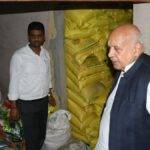Main Points In Hindi (मुख्य बातें – हिंदी में)
-
युवाओं का साहसिक निर्णय: हेमेंट श्रीवास्तव ने अपने माता-पिता के साथ रहने के लिए अमेरिका से लौटकर नई तकनीकों के माध्यम से पारंपरिक खेती से अलग होकर कश्मीरी केसर की खेती शुरू करने का निर्णय लिया।
-
एरोपोनिक्स तकनीक का उपयोग: हेमेंट ने अपनी 300 वर्ग फुट की जगह में एरोपोनिक्स और वर्टिकल फार्मिंग का उपयोग करके बिना मिट्टी और पानी के केसर उगाने की अनूठी पद्धति अपनाई। यह तकनीक पौधों की जड़ों को नियंत्रित पोषक तत्वों के स्प्रे के साथ हवा में लटकाकर काम करती है।
-
ऊँची लागत और बिक्री की संभावनाएं: उन्होंने बताया कि 1 किलोग्राम केसर की खुदरा कीमत 6 से 8 लाख रुपये होगी। वे अपने उत्पादन की गुणवत्ता को बढ़ाने के लिए उत्तम गुणवत्ता के बल्बों का उपयोग कर रहे हैं।
-
उत्तर प्रदेश में केसर उत्पादन को बढ़ावा: हेमेंट का मानना है कि एरोपोनिक और वर्टिकल फार्मिंग तकनीकों का उचित उपयोग करके उत्तर प्रदेश के जैसे क्षेत्रों में केसर की खेती को बढ़ावा दिया जा सकता है, जिससे स्थानीय स्तर पर रोजगार के अवसर भी बढ़ेंगे।
- आत्मनिर्भरता की दिशा में कदम: भारत वर्तमान में 92% केसर ईरान से आयात करता है। हेमेंट की यह पहल न केवल यूपी में केसर को प्रमोट करेगी, बल्कि इससे भारत को आत्मनिर्भर बनाने की दिशा में भी एक महत्वपूर्ण कदम उठाया जा रहा है।
Main Points In English(मुख्य बातें – अंग्रेज़ी में)
-
Innovative Saffron Farming: Hemant Srivastava from Lucknow has successfully ventured into growing Kashmiri saffron using the aeroponic technique, which allows cultivation without soil and water, making it possible to produce this high-value crop outside its traditional environment in Kashmir.
-
Significant Investment: He established a sophisticated farming setup in a 300-square-foot area of his home, costing between INR 30 to 40 lakh, integrating modern technology such as chillers, humidifiers, and LED lights to create ideal growing conditions for saffron.
-
High Market Value: With the potential to yield premium-quality saffron, Hemant anticipates selling it at retail prices ranging from INR 6 to 8 lakh per kilogram, significantly enhancing the economic viability of saffron cultivation in regions like Uttar Pradesh.
-
Potential for Local Employment: Srivastava emphasizes that by adopting aeroponic and vertical farming methods, saffron farming can boost local employment opportunities and contribute to India’s self-reliance in saffron production, which currently relies heavily on imports from Iran.
- Quality Assurance: To ensure top-quality saffron production, Hemant plans to send the harvested saffron to a lab in Kashmir for quality testing, aiming to sell it at around INR 600 to 700 per gram based on its premium quality.
Complete News In Hindi(पूरी खबर – हिंदी में)


अगर इरादे मजबूत हों, तो असंभव भी संभव हो सकता है। लखनऊ के गोमतीनगर के विजयंत खंड के निवासी हेमंत श्रीवास्तव ने इसे साबित किया है। पारंपरिक खेती से हटकर, उन्होंने एरोपोनिक तकनीक के माध्यम से बिना मिट्टी और पानी के कश्मीरी केसर (मोहर) उगाने का अनोखा प्रयोग किया। भारतीय किसान आज से बातचीत में हेमंत ने बताया कि वह MBA करने के बाद अमेरिका के सैन फ्रांसिस्को में काम कर रहे थे। लेकिन वह अपने माता-पिता के साथ रहना चाहते थे, इसलिए उन्होंने भारत लौटकर कुछ अलग करने का फैसला किया।
300 वर्ग फीट में 40 लाख का सेटअप
हेमंत ने बताया कि उनके पिता, डीके श्रीवास्तव, 2016 में जिला जज के पद से रिटायर हुए थे, और उन्हें खेती में रुचि थी, इसी वजह से उन्होंने कश्मीरी केसर की खेती करने का फैसला किया। हेमंत ने बताया कि उन्होंने अपने घर के 300 वर्ग फीट में एक सेटअप तैयार किया और 10 टन केसर के बीज लगाए। सभी बीज कश्मीर से लाए गए थे। 38 वर्षीय हेमंत बताते हैं कि केसर कश्मीर की ठंडी जलवायु और विशेष मिट्टी में उगता है, जिससे इसे भारत के अन्य हिस्सों में उगाना कठिन होता है। उन्होंने कहा कि उनके घर की पहली मंजिल पर 300 वर्ग फीट की जगह खाली थी, जहाँ सेटअप बनाया गया। इस कमरे में दो चिलर, एक ह्यूमिडिफायर, LED और प्रकाश संश्लेषण की बत्तियाँ लगाई गईं।
1 किलो केसर की खुदरा कीमत 6 से 8 लाख रुपये होगी।
इसके बाद उन्होंने दिल्ली से एक ट्रे मंगवाई और एक रैक बनवाया। केसर की खेती में इसके मूल बीजों का प्रयोग होता है, जिन्हें बल्ब कहते हैं। ये बल्ब कश्मीर और बाहरी जगहों से लाए गए थे। इस पर लगभग 30 से 40 लाख रुपये की लागत आई। जब लैब तैयार हुई, तब बीज सितंबर में लगाए गए। अब उम्मीद है कि पहली फसल में 1 किलो केसर पैदा होगा।
कुसुम भी आना शुरू हो गए हैं और कई लोग लखनऊ में उन्हें खरीदने के लिए कॉल कर रहे हैं। 1 किलो केसर की खुदरा कीमत 6 से 8 लाख रुपये होगी। हेमंत ने बताया कि केसर की खेती को वर्टिकल फार्मिंग के रूप में अपनाया गया है, जिससे कम जगह में अधिक बीज उत्पादित किए जा सकते हैं। इसे ऑनलाइन और ऑफलाइन दोनों तरीकों से बेचा जाएगा।
एरोपोनिक तकनीक कैसे है?
हेमंत ने अपने घर के वातानुकूलित हॉल में एरोपोनिक और वर्टिकल फार्मिंग का उपयोग करके केसर की खेती शुरू की। एरोपोनिक प्रणाली में, पौधों को हवा में लटकाया जाता है और उनके मूल को नियंत्रित पोषक तत्वों से भरपूर धुंध (स्प्रे) प्रदान किया जाता है। उन्होंने बताया, ‘इस तकनीक से हम सीमित जगह में अधिकतम पौधे उगा सकते हैं।’ इसके अलावा, वर्टिकल फार्मिंग के माध्यम से उन्होंने दो कमरों को तोड़कर एक हॉल बनाया, जिससे उत्पादन बढ़ा। उन्होंने कहा कि यह एक बार का निवेश योजना है, अब आगे की आय होगी।
उत्तर प्रदेश में केसर की खेती को मिलेगा बढ़ावा
लखनऊ के निवासी हेमंत श्रीवास्तव ने कहा कि केसर की कीमत उसकी गुणवत्ता से निर्धारित होती है। प्रीमियम गुणवत्ता का केसर 500 रुपये प्रति ग्राम की लागत पर बेचा जाता है। इसलिए, केसर निकालने के बाद, हम इसकी गुणवत्ता जांच के लिए इसे कश्मीर की एक लैब में भेजेंगे। हमने खेती के लिए उच्च गुणवत्ता के बल्ब का उपयोग किया है। इस उम्मीद के साथ, हम केसर को 600 से 700 रुपये प्रति ग्राम की दर से बेच सकेंगे।
वह मानते हैं कि एरोपोनिक और वर्टिकल फार्मिंग तकनीकों का सही उपयोग करके, लखनऊ जैसे स्थानों पर केसर की खेती को बढ़ावा दिया जा सकता है। इससे न केवल स्थानीय स्तर पर रोजगार के अवसर बढ़ेंगे, बल्कि उच्च गुणवत्ता केसर का उत्पादन भी संभव होगा। वर्तमान में भारत 92% केसर ईरान से आयात करता है। हेमंत का प्रयास उत्तर प्रदेश में केसर की खेती को बढ़ावा देने के साथ-साथ भारत को आत्मनिर्भर बनाने की दिशा में एक बड़ा कदम है।
Complete News In English(पूरी खबर – अंग्रेज़ी में)
If intentions are strong then even the impossible can be made possible. Hemant Srivastava, resident of Vijayant Khand of Gomtinagar in the capital Lucknow, has proved this. Moving away from traditional farming, he made a unique experiment of growing Kashmiri saffron i.e. Mogra without soil and water through aeroponic technique. Till the farmers of India Today While talking to Hemant, he told that he was working in San Francisco, America after MBA. But he wanted to stay with his parents, so he planned to come to India and do something different.
40 lakh setup in 300 square feet
He told that my father DK Srivastava had retired from the post of District Judge in the year 2016, he was more interested in farming, hence we decided to cultivate Kashmiri saffron separately. MBA pass Hemant Srivastava further told that he has prepared a setup in 300 square feet of his house and planted 10 tons of saffron seeds. All the seeds were brought from Kashmir. Hemant, 38, explains that saffron is cultivated in the cold climate and unique soil conditions of Kashmir, which makes it difficult to grow it in other parts of India. He told that 300 square feet of space was vacant on the first floor of the house. Got the setup done at this place. Two chillers, humidifier, LED and photosynthesis lights were installed in the room.
1 kg saffron will be sold in retail for Rs 6 to 8 lakh.
Then ordered a tray from Delhi and got a rack made. In the cultivation of saffron, its root seeds are used, which are called bulbs. These bulbs were brought from Kashmir and outside. It cost Rs 30 to 40 lakh. After the lab was ready, the seeds were planted in September this year. It bloomed in the month of July 2024. Hemant hopes that one kilo of saffron will be produced as the first crop.
Flowers have also started arriving and many people are calling in Lucknow to buy them. One kg of saffron will be sold in retail for Rs 6 to 8 lakh. He told that saffron cultivation has been given the form of vertical farming, through which more seeds can be produced in less space. It will be sold both online and offline.
How is aeroponic technology?
Hemant started saffron cultivation using aeroponic and vertical farming in an air-conditioned hall of his house. In an aeroponic system, plants are suspended in air and their roots are provided with a controlled nutrient-rich mist (spray). He told, ‘With this technology we can grow maximum plants in limited space.’ Apart from this, through vertical farming, he broke two rooms and built a hall, due to which he got more production. He told that this is a one time investment plan, now there will be further income.
Saffron cultivation will get a boost in UP
Lucknow resident Hemant Srivastava said that the price of saffron is decided by its quality. Premium quality is sold at a cost of Rs 500 per gram. In such a situation, after extracting saffron, we will send it to a lab in Kashmir to get its quality tested. We have used best quality bulbs for farming. In such a situation, it is expected that we will be able to sell saffron at the rate of Rs 600 to Rs 700 per gram.
He believes that by properly using aeroponic and vertical farming techniques, saffron cultivation can be promoted in areas like Lucknow also. This will not only increase employment opportunities at the local level, but will also make it possible to produce high quality saffron. Currently India imports 92% saffron from Iran. This effort of Hemant is a big step towards promoting saffron cultivation in Uttar Pradesh as well as making India self-reliant.




